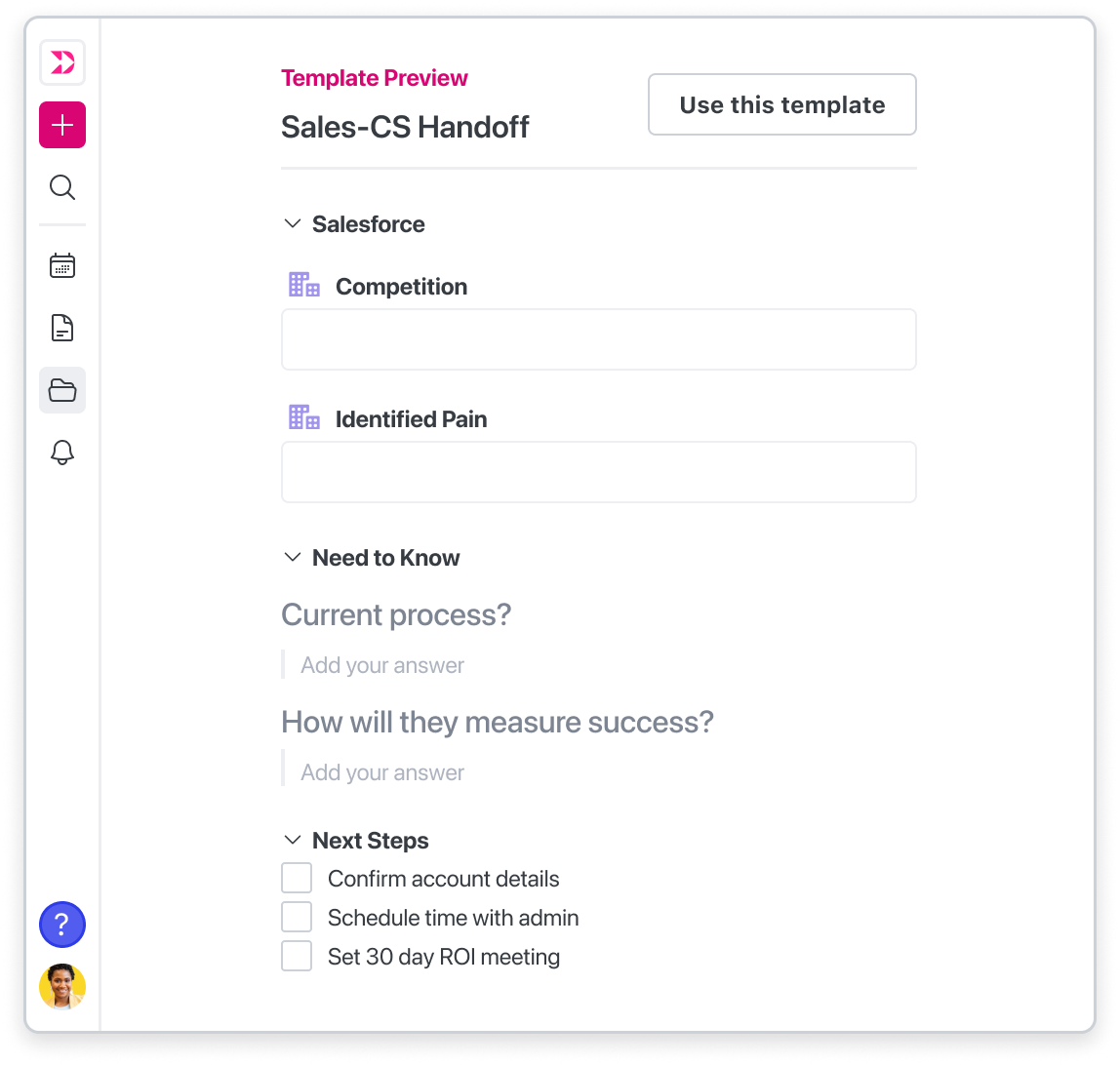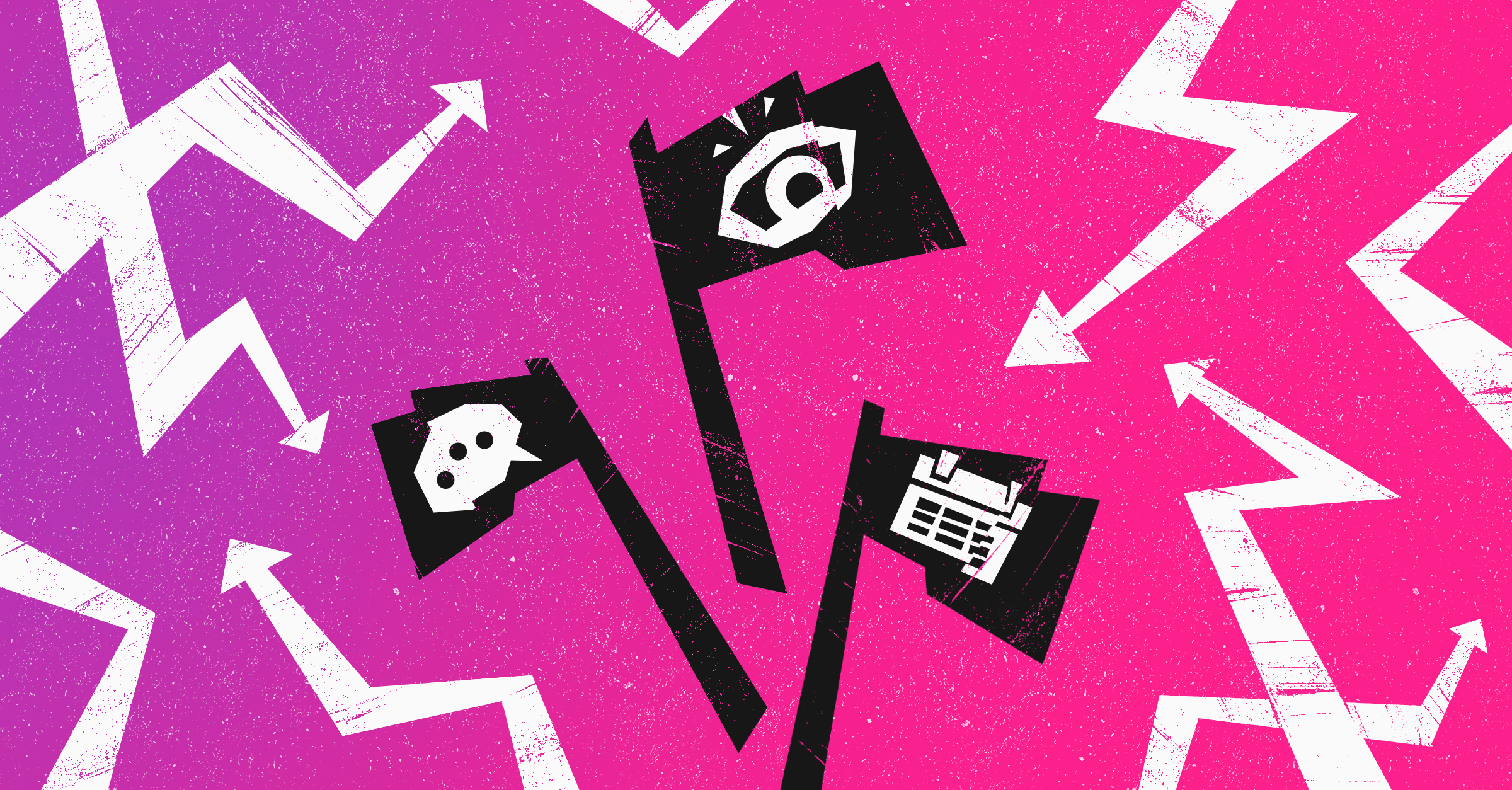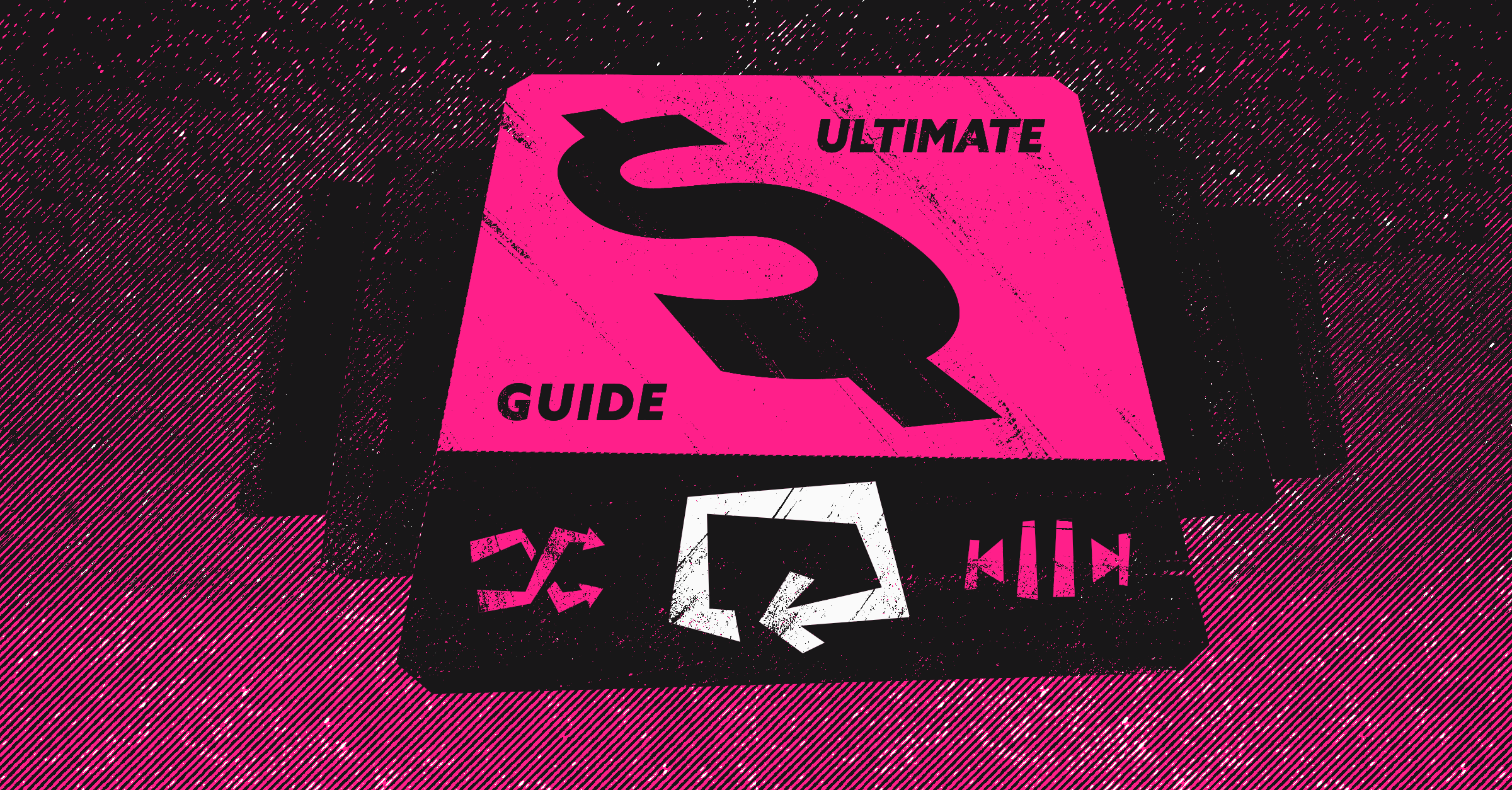
While signing new customers is a win for any sales team, 🏁 close-won is the beginning of another journey.
The whole company needs to continue delivering as soon as the black is on the white on that DocuSign. You want to make that new customer feel confident that you’re not just focused on meeting sales targets but genuinely keeping up with what you promised AND what your product or services actually promises.
You know all the jargon: helping them unlock value, and ultimately impacting their day-to-day. And, you’ll have friends—not annoyed colleagues!—across the implementation, CS, and sales teams.
To do this right, your organization needs to develop a seamless transition from sales to customer success.
To make your job easier, we’ve created a sales-to-customer success handoff template to help your CSMs come to onboarding calls prepared. And not just that, to ensure the handoff is repeatable and consistent.
This template is included in your free Dooly plan.
Includes fields that update Salesforce or retrieve existing info.
Start with this template
What goes into a sales-to-customer-success handoff document?
This template should contain all the types of information collected during the sales process (by the AE and any others who were involved). Often, this includes:
- Customer expectations
- Goals to achieve in using your solution
- A summary of key interactions with the customer that might affect how the CSM doing the onboarding approaches them
- Any additional intelligence about the customer’s needs and journey (e.g., previous vendors used, motivations for purchasing your product)
Typically, information like this lives within your CRM (customer relationship management) tool. Ideally, it would arrive there via a template from your pipeline management tool. However, there may be gaps where information exists only in the heads of sellers. Formalizing the handoff with this document ensures everyone has all the details, and nothing gets lost in the shuffle.
Remember, your ultimate goal is to make the customer feel so valued that they’re confident they made the right choice. Because first impressions matter.
The importance of a smooth transition: reduce friction and improve retention
The sales to CSM (customer success manager) handoff must also be smooth so that onboarding begins without any misconceptions internally. When this occurs, it’s a win-win for all parties. Having these steps documented prevents tension between Sales and Implementation (or Customer Success), wasted time, and miscommunication.
Check out this case study featuring ThoughtExchange to learn how handoff improvements led to increased net customer retention and greater CSM productivity (and joy!).
Avoiding broken promises in the sales-to-customer success transition
The sales to CS (customer success) transition is the first part of the customer’s new journey with your company. No one wants it to start bumpy. Do AEs sometimes accidentally over promise or miss high-value features when working with prospects? Sure they do: salespeople are human, too (speaking as one!). And customers often forget every detail of what their AE said to them, perhaps in a case of wishful thinking (this happens a lot!) These issues often come to light with SaaS solutions as plans and feature sets are more complex, and customer requirements vary. The overpromise isn’t usually intentional, especially when there are product knowledge gaps for new sellers.
If this happens, your brand new customer isn’t coming into that relationship ready to refer you to all their friends and give you a big “10” on their first NPS. Customer success teams have to then rebuild relationships with the new customers from a place of weakness. Start by building rapport with new customers to support retention and make sure they feel valued. Remember, even Jason Lemkin, Founder of SaaStr, has long thought of customer success as being where “90% of the revenue is”; whether you outright agree with this sentiment or not, it can make or break the success of your new business effort.
Additionally, the more CSMs know about an account, the more personalized and relevant interactions will be. They can take this information to craft a customized implementation experience. It speeds up a customer’s adoption of the platform, too.
Providing a connected and valuable onboarding program matters to customers, as 63% of buyers consider it when making purchasing decisions.
When CSMs have a handover document, they have all the insights to get moving.
They won’t have to ask or repeat questions in their first conversations.
They can confirm things, demonstrating to your customers that you know them.
They can create a new customer experience that feels magical in how smooth it is.
That is our goal.
So, how should this handoff work?
Preparing for the handoff
In preparation for the handoff, sales and customer success teams should understand the customer’s journey. This should happen through evergreen, ongoing training for sellers led by Marketing or Product Marketing. The customer journey includes all the steps buyers take to become a customer. All those interactions highlight their motivations, needs, and expectations. What marketing content did they view that kicked off the buying process? Or did the SDR team reach out to the customer as a means of getting the discussion going?
Another aspect of the prep for handoff is identifying key stakeholders that play a role in the customer relationship. Define what their responsibilities are in supporting the customer after the sale. Is there a separate implementation manager from the CSM or account manager, and if so, what milestones will cause that future handoff to occur?
All this information should end up in your CRM. Salespeople take lots of notes in conversations, which can be time-consuming to translate to the CRM manually, if it happens at all, so using a tool for Salesforce notes automatically syncs them, saving time and ensuring clarity.
What elements should your sales-to-customer-success handoff include?
We say there are three essentials for a successful handoff:
- Communication plan 🗺️
- Documentation 📑
- Introduction meeting 📅
🗺️ Communication plan
Defining a communication strategy with customers is critical to success. For example, customers often contact their salesperson with help requests after onboarding because of the existing relationship. Drafting a communication plan to handle this ensures customers get the attention they need. Will salespeople be involved? Will they help out for a time, or will they gracefully defer post-sale questions to CS while staying CC’d (or maybe even not staying CC’d intentionally)?
To ensure consistency in communication, consider:
- Creating Slack or Teams channels for handoffs, but only putting information here that is too ‘noisy’ to belong in the Handoff document
- Using the CRM to note important new information and tagging customer success managers on those notes
📑 Documentation
The next step is creating the handoff document. Start by using a sales-to-customer success handoff template (like the one above!). It should include the following if this info isn’t already clearly delineated within CRM:
- Company details (e.g., industry, size, location, etc.) and primary contacts/admin users
- Contract information (e.g., length, number of seats, billing cycle)
- Assigned customer success manager
- Customer objectives and what they want to achieve, which often come from the pain points initially described in the sales process
- Any known objections, points of friction, or areas of skepticism
- Defining success internally and with the customer based on metrics to track
- Potential red flags (e.g., non-standard contract clauses or other redlines that were involved)
- Customer history, including previous products they’ve used, other systems they compared to yours, integrations they need, most essential features, and more
- Tasks the customer success manager should complete after onboarding
- Special requests from the customer, if any (make sure this section is highlighted so it’s unmistakable!)
After document creation, it’s time for everyone to meet.
📅 Introduction meeting
The formal transition from sales to customer success begins with the introductory meeting. A signed contract should trigger the workflow to schedule this meeting from within your customer success platform or CRM. Having such a tool makes the handoff efficient and improves productivity by reducing repetitive admin tasks, which 66% of CSMs report taking up a significant portion of their workday.
To schedule and conduct an effective meeting, follow these workflow steps:
- The internal handoff with the document moves from sales to customer success.
- CSMs reply to sales with any questions or gaps in the information.
- The salesperson makes the initial introduction with an email, copying the CSM. You should have standard language for this that conveys gratitude and excitement.
- The CSM then replies to the introduction email with a standard response about who they are, how they’ll help, and the onboarding process. Additionally, they should include a summary of what they learned from the handoff document to prove that they’re already on the ball and engaged. The CSM also then requests a meeting, which is easier to schedule if you have a link to a calendar for customers to use.
After the meeting is on the books, CSMs should send an agenda on what they’ll cover in the call, including setting clear expectations. This is also a great time to specifically call out whether an official change in the customer’s Point Of Contact has occurred and to whom. If there will be successive handoffs as well, such as from Implementation manager to Account Manager, make that clear here so that the customer isn’t surprised 1-2 months down the road.
Best practices for good sales-to-customer-success handoff
With documentation and workflows in place, you’ll also want to keep these best practices in mind for a smooth transition.
1. Ensure sales captures relevant data for CS
As we’ve mentioned, the sales team captures lots of information during the sales cycle. Some of this is critical for customer success to facilitate an excellent onboarding process, some is unnecessary noise. Tools that help make filtering this information into CRM easy include note-syncing tools and sales call templates, which focus on asking the right questions. They both auto-sync to SFDC, which improves hygiene.
2. Be proactive in answering questions from CS
A CSM who receives new customers will undoubtedly have questions for the seller. Most of these should be part of your handoff document. If salespeople complete this entirely and accurately, it cuts down on the back-and-forth and gets onboarding rolling faster.
CSMs hate to always have to ask the same questions of AEs, over and over. The Director of CS can often step in here, working with the Director of Sales to make any necessary refinements to the Handoff Template overall.
3. Define communication channels
Communication styles can differ across teams, so you want to have some overarching rules around this. It should be simple and not involve long strings of emails. Instead, look for ways to integrate sales deal tools with Slack for lower-signal-strength comments and CRM for tasks.
Customers should also know how to access support when they need it and from whom. This might include direct channels to their CSM and also sharing self-service options like knowledge bases that can allow them to get faster response times on simple day-to-day questions.
4. Create mandatory fields in Salesforce wisely
A best practice that ensures sellers don’t miss critical information is having mandatory fields in Salesforce before the handoff. Ensure these fields are completed on all new deals, usually via Validation Rules:
- Onboarding contacts
- Platforms, features, etc., the customer contracted for
- Any non-standard agreement language or redlines
- Who their previous vendor was, if they had one
- Client-specific data that must be loaded into the tool by the implementation team or CSM
- A brief summary of the sales process
5. Regular check-ins
Customer success should conduct regular check-ins with customers and proactively tell them during the onboarding process how these check-ins will go and how frequently they’ll be held. For your most high-touch customers, CSMs should meet with them every month or even more to manage expectations and gauge satisfaction, especially if any software customization was done for these customers.
6. Continuous improvement
Your sales-to-customer success handoff is a living strategy that will need refinement. Your sales and customer success teams should revisit it at least quarterly or whenever the handoff proves to be problematic. During these, the heads of Sales and CS can talk about what’s working and what needs improvement. If you collect customer feedback on onboarding and support, use these metrics to make data-driven decisions. Net Revenue Retention should be the lagging indicator KPI here, and Post-Onboarding NPS should be the leading one.
7. Early wins
Help your customers achieve quick wins with your solution based on what they said upfront and what their main goals were. Early success validates their purchase decision and increases their commitment. This also will be a great time to ask them for referrals to other potential customers. Customer success should have information around their goals and be able to tailor onboarding to meet them faster.
How Dooly can help
Dooly focuses on sales productivity and helping businesses retain customers for the long term. We make Salesforce admin work easy, not a burden. Discover Dooly’s pre-built template solutions that are shareable across teams, leading to happier CSMs and even happier customers.
Join the thousands of top-performing AEs who use Dooly every day to stay more organized, instantly update their pipeline, and spend more time selling instead of mindless admin work. Try Dooly free, no credit card required. Or, Request a demo to speak with a Dooly product expert right now.


